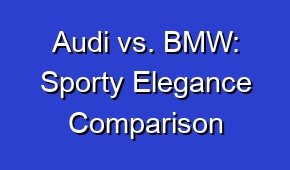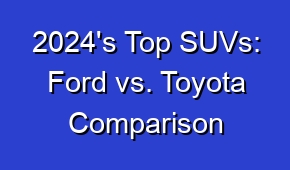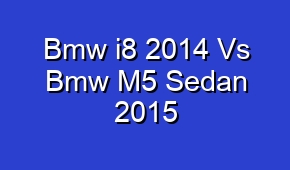Ford Explorer 2017 Vs Ford Expedition 2018

Compare the Ford Explorer 2017 and Ford Expedition 2018 models to determine which one suits your needs. Explore the differences in features, performance, and design to make an informed decision. Discover the standout qualities of each SUV and find the perfect fit for your lifestyle.
| Feature | Ford Explorer 2017 | Ford Expedition 2018 |
|---|---|---|
| Engine | 3.5L V6 | 3.5L V6 |
| Horsepower | 290 hp | 375 hp |
| Torque | 255 lb-ft | 470 lb-ft |
| Transmission | 6-speed automatic | 10-speed automatic |
| Drive Type | Front-wheel drive (optional all-wheel drive) | Rear-wheel drive (optional all-wheel drive) |
| Seating Capacity | 7 | 8 |
| Cargo Space | 21.0 cu ft behind 3rd row, 43.9 cu ft behind 2nd row, 81.7 cu ft behind 1st row | 20.9 cu ft behind 3rd row, 63.6 cu ft behind 2nd row, 104.6 cu ft behind 1st row |
| Fuel Economy | 17 mpg city, 24 mpg highway | 17 mpg city, 24 mpg highway |
| Infotainment System | Sync 3 with 8-inch touchscreen | Sync 3 with 8-inch touchscreen |
| Apple CarPlay / Android Auto | Yes | Yes |
| Blind Spot Monitoring | Available | Available |
| Lane Keep Assist | Available | Available |
| Adaptive Cruise Control | Available | Available |
| Frontal Crash Rating (NHTSA) | 5 stars | 5 stars |
| Overall Rating (NHTSA) | 5 stars | 5 stars |
Engine
The Ford Explorer 2017 and Ford Expedition 2018 both come with a 3.5L V6 engine, offering a balanced blend of power and efficiency.
Horsepower
The Ford Expedition 2018 outperforms the Ford Explorer 2017 in terms of horsepower, with 375 hp compared to 290 hp, providing a more exhilarating driving experience.
Torque
The Ford Expedition 2018 boasts significantly higher torque than the Ford Explorer 2017, with 470 lb-ft compared to 255 lb-ft, resulting in improved acceleration and towing capabilities.
Transmission
While the Ford Explorer 2017 is equipped with a 6-speed automatic transmission, the Ford Expedition 2018 offers a more advanced 10-speed automatic transmission, delivering smoother shifts and better efficiency.
Drive Type
The Ford Explorer 2017 offers front-wheel drive with optional all-wheel drive, while the Ford Expedition 2018 provides rear-wheel drive with optional all-wheel drive, catering to different driving preferences and conditions.
Seating Capacity
The Ford Explorer 2017 can accommodate up to 7 passengers, while the Ford Expedition 2018 offers seating for 8 individuals, making it a better choice for larger families or those in need of extra passenger space.
Cargo Space
Both vehicles offer ample cargo space, but the Ford Expedition 2018 surpasses the Ford Explorer 2017 with more room behind the 3rd, 2nd, and 1st rows, providing greater flexibility for carrying luggage and larger items.
Fuel Economy
Both the Ford Explorer 2017 and Ford Expedition 2018 offer the same fuel economy ratings, with an estimated 17 mpg in the city and 24 mpg on the highway, ensuring efficient performance for daily commuting and long trips.
Infotainment System
Both models are equipped with the Sync 3 infotainment system featuring an 8-inch touchscreen, allowing for intuitive control of various multimedia and connectivity features.
Apple CarPlay / Android Auto
Both the Ford Explorer 2017 and Ford Expedition 2018 support Apple CarPlay and Android Auto, enabling seamless integration of smartphones for hands-free calling, messaging, and accessing compatible apps.
Blind Spot Monitoring
Both vehicles offer the convenience and safety of blind spot monitoring, alerting drivers to vehicles in their blind spots and assisting in lane change maneuvers.
Lane Keep Assist
Both the Ford Explorer 2017 and Ford Expedition 2018 feature lane keep assist, providing gentle steering inputs to help keep the vehicle centered within its lane, enhancing safety during highway driving.
Adaptive Cruise Control
Both models are equipped with adaptive cruise control, which automatically adjusts the vehicle’s speed to maintain a safe distance from the vehicle ahead, reducing driver fatigue and enhancing convenience on long journeys.
Frontal Crash Rating (NHTSA)
Both the Ford Explorer 2017 and Ford Expedition 2018 have received a 5-star frontal crash rating from the National Highway Traffic Safety Administration (NHTSA), indicating their strong safety performance in frontal impact collisions.
Overall Rating (NHTSA)
Both vehicles have achieved a 5-star overall rating from the NHTSA, reflecting their excellent safety features, crashworthiness, and overall performance in various safety tests and evaluations.





















